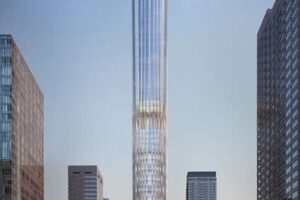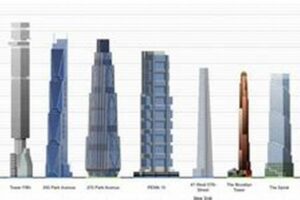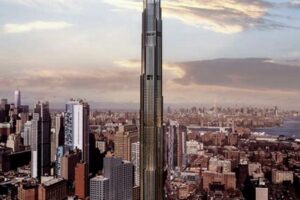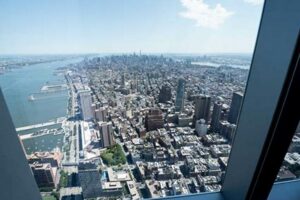A skyscraper is a very tall, multi-story building. The term “skyscraper” is often used to refer to buildings that are at least 150 meters (492 feet) tall. Skyscrapers are typically built in urban areas, and they can be used for a variety of purposes, including offices, residential units, and retail space.
Skyscrapers have been around for over a century, and they have become an iconic part of the skylines of many cities around the world. The first skyscraper was built in Chicago in 1885. Today, there are skyscrapers in cities all over the world, and they continue to be built at an increasing rate.
Skyscrapers offer a number of benefits, including increased density, improved energy efficiency, and reduced transportation costs. They can also be used to create more green space in urban areas.
1. Height
The height of New York City’s skyscrapers is a defining characteristic of the city’s skyline. The city is home to some of the tallest buildings in the world, including One World Trade Center, the Empire State Building, and the Chrysler Building. These buildings are not only iconic landmarks, but they also play a vital role in the city’s economy and culture.
The height of New York City’s skyscrapers has been a major factor in the city’s development. The city’s first skyscrapers were built in the late 19th century, and they quickly became a symbol of the city’s economic power and ambition. In the early 20th century, New York City became a center for skyscraper construction, and the city’s skyline was transformed by the construction of some of the world’s tallest buildings.
The height of New York City’s skyscrapers has also had a significant impact on the city’s culture. The city’s skyscrapers have been featured in countless movies, TV shows, and works of literature. They have also been the inspiration for many works of art. The city’s skyscrapers are more than just buildings; they are also cultural icons.
The height of New York City’s skyscrapers is a major factor in the city’s economy. The city’s skyscrapers provide jobs for thousands of people and generate billions of dollars in revenue each year. They are also a major tourist attraction, and they help to make New York City one of the most popular tourist destinations in the world.
2. Architecture
The architecture of New York City’s skyscrapers is a major factor in their iconic status. The city’s skyscrapers are known for their innovative and iconic designs, and many of them were designed by renowned architects. This has resulted in a collection of buildings that are not only visually stunning, but also architecturally significant.
One of the most important aspects of New York City’s skyscraper architecture is its diversity. The city’s skyscrapers represent a wide range of architectural styles, from the Gothic Revival style of the Woolworth Building to the Art Deco style of the Empire State Building to the modernist style of the Seagram Building. This diversity is a reflection of the city’s own diversity, and it makes New York City’s skyline one of the most interesting and varied in the world.
Another important aspect of New York City’s skyscraper architecture is its focus on innovation. The city’s skyscrapers have always been at the forefront of architectural innovation, and they continue to be so today. This is due in part to the city’s competitive real estate market, which has forced architects to come up with new and innovative ways to design buildings that are both tall and efficient.
The architecture of New York City’s skyscrapers is a major part of what makes the city so unique. The city’s skyscrapers are not only visually stunning, but they are also architecturally significant. They represent a wide range of architectural styles and they are at the forefront of architectural innovation. New York City’s skyscrapers are a testament to the city’s own diversity and vitality.
3. History
The history of skyscraper construction in New York City is closely intertwined with the development of “hism nyc skyscraper”. The term “hism nyc skyscraper” refers to the iconic and innovative skyscrapers that have come to define the New York City skyline. These skyscrapers are not only architectural marvels, but they are also symbols of the city’s economic and cultural power.
The construction of the first skyscraper in New York City in 1885 marked a turning point in the city’s history. This building, the Home Insurance Building, was the first to exceed 10 stories in height. It was followed by a wave of skyscraper construction that transformed the city’s skyline. By the early 20th century, New York City was home to some of the tallest buildings in the world, including the Empire State Building and the Chrysler Building.
The construction of skyscrapers in New York City was driven by a number of factors, including the city’s growing population, the need for more office space, and the desire to create iconic landmarks. Skyscrapers also allowed for the more efficient use of land, which was at a premium in New York City. The construction of skyscrapers in New York City has had a profound impact on the city’s development. Skyscrapers have helped to create a dense and vibrant urban environment, and they have played a major role in the city’s economic growth. Skyscrapers are also a major tourist attraction, and they help to make New York City one of the most popular tourist destinations in the world.
The history of skyscraper construction in New York City is a story of innovation and ambition. The city’s skyscrapers are a testament to the ingenuity and creativity of the architects and engineers who designed and built them. Skyscrapers are also a symbol of the city’s economic and cultural power. They are a reminder of New York City’s rich history and its bright future.
4. Culture
The connection between “Culture: New York City’s skyscrapers are more than just buildings; they are also cultural icons. They have been featured in countless movies, TV shows, and works of literature.” and “hism nyc skyscraper” is significant. Skyscrapers are a defining feature of the New York City skyline, and they have played a major role in the city’s culture and identity. Skyscrapers have been featured in countless movies, TV shows, and works of literature, and they have become iconic symbols of the city.
The Empire State Building, for example, has been featured in countless movies and TV shows, including “King Kong” (1933), “Sleepless in Seattle” (1993), and “Elf” (2003). The Chrysler Building has also been featured in numerous movies and TV shows, including “Spider-Man” (2002), “Men in Black” (1997), and “The Amazing Spider-Man” (2012). These buildings are not only architectural marvels, but they are also cultural icons that have come to represent the city of New York.
The connection between “Culture: New York City’s skyscrapers are more than just buildings; they are also cultural icons. They have been featured in countless movies, TV shows, and works of literature.” and “hism nyc skyscraper” is also important because it highlights the role that skyscrapers play in the city’s economy. Skyscrapers are a major tourist attraction, and they help to make New York City one of the most popular tourist destinations in the world. Skyscrapers also provide jobs for thousands of people, and they generate billions of dollars in revenue each year. The connection between “Culture: New York City’s skyscrapers are more than just buildings; they are also cultural icons. They have been featured in countless movies, TV shows, and works of literature.” and “hism nyc skyscraper” is a complex and multifaceted one. Skyscrapers are not only architectural marvels, but they are also cultural icons that play a major role in the city’s economy and identity.
5. Economy
Skyscrapers are a major part of the New York City economy. They provide jobs for thousands of people in a variety of industries, including construction, architecture, engineering, and real estate. Skyscrapers also generate billions of dollars in revenue each year through rent, tourism, and other sources.
The connection between skyscrapers and the New York City economy is a mutually beneficial one. Skyscrapers provide jobs and revenue for the city, and the city provides a market for skyscrapers. This relationship has helped to make New York City one of the most prosperous cities in the world.
Here are some specific examples of how skyscrapers contribute to the New York City economy:
- Jobs: Skyscrapers provide jobs for thousands of people in a variety of industries. These jobs include construction workers, architects, engineers, real estate agents, and property managers.
- Revenue: Skyscrapers generate billions of dollars in revenue each year through rent, tourism, and other sources. Rent is the largest source of revenue for skyscrapers, but tourism is also a significant contributor. Millions of tourists visit New York City each year to see the city’s iconic skyscrapers.
- Economic growth: Skyscrapers contribute to economic growth by creating jobs, generating revenue, and attracting tourists. Skyscrapers also help to create a more vibrant and prosperous city environment.
The connection between “Economy: New York City’s skyscrapers are a major economic driver for the city. They provide jobs for thousands of people and generate billions of dollars in revenue each year.” and “hism nyc skyscraper” is a complex and multifaceted one. Skyscrapers are not only architectural marvels, but they are also economic powerhouses that play a major role in the city’s economy. The understanding of this connection is essential for anyone who wants to understand the New York City economy.
6. Tourism
Skyscrapers are a defining feature of the New York City skyline, and they are a major tourist attraction. Millions of people visit the city each year to see these iconic buildings. The connection between tourism and “hism nyc skyscraper” is significant, as skyscrapers are a major part of what makes New York City such a popular tourist destination.
- Economic Impact
Skyscrapers generate billions of dollars in revenue for New York City each year through tourism. Tourists spend money on hotels, restaurants, transportation, and other services while visiting the city to see its skyscrapers.
- Cultural Impact
Skyscrapers are a major part of New York City’s culture and identity. They have been featured in countless movies, TV shows, and works of literature. Tourists come to New York City to experience the city’s culture, and skyscrapers are a major part of that experience.
- Architectural Impact
Skyscrapers are architectural marvels, and tourists come to New York City to see them up close. The city’s skyscrapers are a testament to the ingenuity and creativity of the architects and engineers who designed and built them.
- Historical Impact
Skyscrapers have played a major role in the history of New York City. The city’s first skyscraper was built in 1885, and the city has continued to build taller and more innovative skyscrapers ever since. Skyscrapers are a reminder of New York City’s rich history and its bright future.
The connection between “Tourism: New York City’s skyscrapers are a major tourist attraction. Millions of people visit the city each year to see these iconic buildings.” and “hism nyc skyscraper” is a complex and multifaceted one. Skyscrapers are not only architectural marvels, but they are also cultural icons that play a major role in the city’s economy and identity. The understanding of this connection is essential for anyone who wants to understand the New York City tourism industry.
7. Sustainability
The connection between “Sustainability: New York City is committed to building sustainable skyscrapers. Many of the city’s newest skyscrapers are designed to be energy-efficient and environmentally friendly.” and “hism nyc skyscraper” is significant, as sustainability is an important consideration in the design and construction of modern skyscrapers. There are many reasons for this, including:
- Environmental concerns: Skyscrapers can have a significant impact on the environment, both during their construction and operation. Sustainable skyscrapers are designed to minimize this impact by using energy-efficient materials and systems, and by reducing waste and pollution.
- Economic benefits: Sustainable skyscrapers can be more cost-effective to operate than traditional skyscrapers. This is because they use less energy and water, and they can generate their own renewable energy.
- Health benefits: Sustainable skyscrapers can improve the health and well-being of their occupants. This is because they provide better air quality, natural light, and access to green space.
There are many examples of sustainable skyscrapers in New York City, including:
- One World Trade Center: This is the tallest building in the United States, and it is also one of the most sustainable. It is designed to use 40% less energy than a traditional skyscraper.
- The Bank of America Tower: This is the second-tallest building in New York City, and it is also one of the most sustainable. It is designed to use 30% less energy than a traditional skyscraper.
- The Hearst Tower: This is a LEED Platinum-certified skyscraper that is designed to use 20% less energy than a traditional skyscraper.
The construction of sustainable skyscrapers is an important part of New York City’s commitment to sustainability. Sustainable skyscrapers help to reduce the city’s environmental impact, improve the health and well-being of its occupants, and create a more sustainable future for the city.
8. Innovation
New York City is a hub for innovation in skyscraper design and construction. The city’s skyscrapers are constantly pushing the boundaries of what is possible. This is due in part to the city’s competitive real estate market, which has forced architects and engineers to come up with new and innovative ways to design buildings that are both tall and efficient.
- New Materials and Technologies
Architects and engineers are constantly developing new materials and technologies to use in skyscraper construction. These new materials and technologies allow for the construction of taller, stronger, and more sustainable skyscrapers. For example, the use of lightweight materials such as carbon fiber and glass fiber has allowed for the construction of skyscrapers that are taller than ever before. - Innovative Structural Systems
Architects and engineers are also developing new structural systems for skyscrapers. These new structural systems allow for the construction of skyscrapers that are more resistant to wind and earthquakes. For example, the use of diagrid structural systems has allowed for the construction of skyscrapers that are taller and more slender than ever before. - Sustainable Design
Architects and engineers are also focusing on sustainable design in the construction of skyscrapers. This includes the use of energy-efficient materials and systems, as well as the incorporation of green spaces and natural light into the design of skyscrapers. For example, the Bank of America Tower in New York City is LEED Platinum-certified and is designed to use 30% less energy than a traditional skyscraper. - Mixed-Use Developments
Skyscrapers are no longer just office buildings. Today, skyscrapers are mixed-use developments that include residential units, retail space, and public amenities. This mixed-use approach allows for the creation of more vibrant and livable communities. For example, the Hudson Yards development in New York City includes residential units, office space, retail space, a public park, and a cultural center.
The innovation in skyscraper design and construction in New York City is constantly pushing the boundaries of what is possible. This innovation is not only creating taller and more sustainable skyscrapers, but it is also creating more vibrant and livable communities.
FAQs About “hism nyc skyscraper”
This section provides answers to frequently asked questions about “hism nyc skyscraper”.
Question 1: What is the tallest building in New York City?
One World Trade Center is the tallest building in New York City, standing at 1,776 feet tall.
Question 2: What is the oldest skyscraper in New York City?
The Home Insurance Building is the oldest skyscraper in New York City, built in 1885.
Question 3: What is the most sustainable skyscraper in New York City?
The Bank of America Tower is the most sustainable skyscraper in New York City, achieving LEED Platinum certification.
Question 4: What is the most innovative skyscraper in New York City?
The Hudson Yards development is one of the most innovative skyscrapers in New York City, featuring a mixed-use design that includes residential units, office space, retail space, and public amenities.
Question 5: What is the most expensive skyscraper in New York City?
The 432 Park Avenue skyscraper is one of the most expensive skyscrapers in New York City, with apartments selling for millions of dollars.
Question 6: What is the most iconic skyscraper in New York City?
The Empire State Building is one of the most iconic skyscrapers in New York City, recognized for its Art Deco style and its appearance in numerous movies and TV shows.
These are just a few of the frequently asked questions about “hism nyc skyscraper”. For more information, please consult a reliable source or visit the official website of the Council on Tall Buildings and Urban Habitat.
The discussion of “hism nyc skyscraper” highlights the importance of skyscrapers in New York City. Skyscrapers are not only architectural marvels, but they are also economic powerhouses and cultural icons. They play a major role in the city’s economy, tourism, and sustainability efforts. The continued innovation in skyscraper design and construction in New York City is a testament to the city’s commitment to progress and its status as a global leader in architecture and urban planning.
The next section of this article will explore the challenges and opportunities facing skyscrapers in New York City.
Tips for visiting “hism nyc skyscraper”
Visiting “hism nyc skyscraper” can be a thrilling and unforgettable experience. Here are some tips to make the most of your visit:
Tip 1: Plan ahead.
Some “hism nyc skyscraper” offer timed tickets or require advance reservations, especially during peak tourist season. Check the official website of the skyscraper you plan to visit for information on tickets and reservations.
Tip 2: Arrive early.
This will give you plenty of time to go through security and make your way to the observation deck. You’ll also be able to avoid the crowds that tend to gather later in the day.
Tip 3: Choose a clear day.
The views from the observation deck will be much better on a clear day. If possible, try to visit on a day with good weather conditions.
Tip 4: Bring your camera.
You’ll want to capture the breathtaking views from the observation deck. Make sure to bring your camera or smartphone to take plenty of pictures.
Tip 5: Be prepared for crowds.
“hism nyc skyscraper” are popular tourist destinations, so be prepared for crowds. If you’re visiting during peak tourist season, be patient and allow yourself plenty of time.
Tip 6: Take your time.
Don’t rush your visit. Take your time to enjoy the views and learn about the history of the skyscraper. There are often exhibits and displays on the observation deck that provide interesting information.
Tip 7: Visit at night.
Some “hism nyc skyscraper” offer nighttime visits. This can be a great way to see the city lights and get a different perspective of the skyline.
Tip 8: Consider a guided tour.
Guided tours can provide you with a more in-depth look at the skyscraper and its history. Tours are typically offered at an additional cost.
By following these tips, you can make the most of your visit to “hism nyc skyscraper”.
Remember to check the official website of the skyscraper you plan to visit for the most up-to-date information on tickets, reservations, and hours of operation.
Conclusion
Skyscrapers have played a major role in the development of New York City. They are not only architectural marvels, but they are also economic powerhouses and cultural icons. Skyscrapers have helped to make New York City one of the most prosperous and vibrant cities in the world.
The future of skyscrapers in New York City is bright. The city is committed to building sustainable and innovative skyscrapers that will continue to contribute to the city’s economy, tourism, and sustainability efforts. The continued innovation in skyscraper design and construction in New York City is a testament to the city’s commitment to progress and its status as a global leader in architecture and urban planning.







